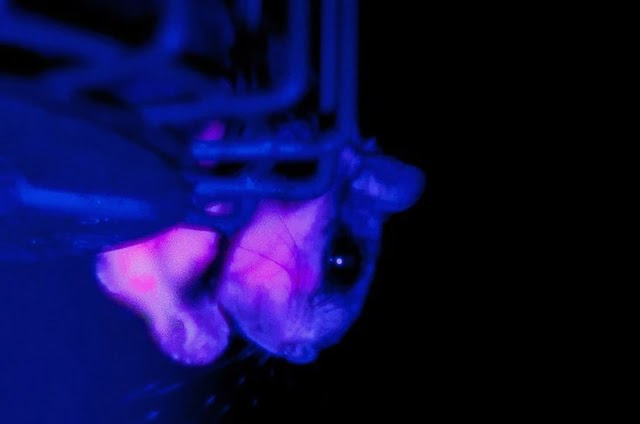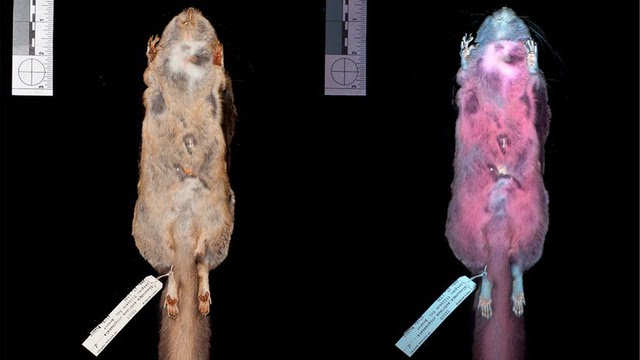Quck answer
Flying squirrels, particularly those in North America, have been found to glow hot pink under ultraviolet (UV) light. This discovery was made by a team of researchers who were studying the animals’ ability to fluoresce. The pink glow is due to a pigment in their fur called hyloin-L1. The purpose of this fluorescence is still unknown, but researchers speculate that it may help the squirrels communicate with each other or deter predators. This unique ability to glow in UV light adds to the list of fascinating adaptations found in the animal kingdom.
Wildlife

A flying squirrel can appear hot pink when exposed to ultraviolet (UV) light. Biologists from Wisconsin recently made the discovery that the fur of three different species of flying squirrels, which are found in North and Central America, emits a bright bubblegum pink color when illuminated with UV light. The pink coloration occurs on both the top and bottom surfaces of the gliders, but it is the underside of their skin flaps that glow the brightest. Jonathan Martin, a biologist from Northland College, discovered the pink hue by chance one evening when he was searching for lichens and other items that fluoresce under UV light in the forest. He aimed his UV flashlight at a southern flying squirrel that glided by and saw the fuchsia flash.
Martin and his colleagues studied the skins of flying squirrels at the Science Museum of Minnesota and the Field Museum in Chicago. They took photos of the skins under both visible and ultraviolet light. All except one of the flying squirrels had the same pink glow, which has been compared to bubblegum, Day-Glo, and 1980s Lycra.

Flying squirrels in the lab — the one on the left under visible light and the one on the right showing up pink under UV illumination.
Journal of Mammalogy
The researchers say that the pink hue is caused by the squirrels’ ability to fluoresce, which is the process of absorbing light of a particular wavelength and emitting it in another wavelength. Only a few mammals, some fish, and some birds can fluoresce. Flying squirrels are nocturnal and are most active at dawn and dusk. No other North American squirrel is known to have the ability to fluoresce. The researchers have yet to test other squirrel species around the world.
The scientists are now curious to know what purpose the fluorescence serves. Humans cannot see ultraviolet light without special lighting, but other animals can. One theory suggests that the pink hue may confuse owls, which prey on flying squirrels. Owls’ undersides also fluoresce pink. Another theory is that the pink hue may attract potential mates, although researchers have yet to find evidence of this phenomenon. Flying squirrels mate throughout the year, and it is unclear whether they can even see ultraviolet light.
The scientists emphasize the fundamental motivation of science- the evidence of how much there is still left to learn. According to the study, “Further research is required to explore the ecological importance of this characteristic.”
Introducing the Indian giant squirrel, an animal adorned with a vibrant coat of black, beige, orange, brown, and a shade resembling mauve and purple.
FAQ
1. What makes flying squirrels glow hot pink in UV light?
Flying squirrels have a special protein in their fur called a fluorescent pigment. This pigment absorbs UV light and emits visible light at a different wavelength, which makes the squirrels appear hot pink in UV light. It is believed that this adaptation helps the squirrels communicate with each other and avoid predators.
2. Do all flying squirrels glow hot pink in UV light?
No, not all flying squirrels glow hot pink in UV light. This unique adaptation has only been observed in a few species of flying squirrels, including the North American southern flying squirrel and the Siberian flying squirrel.
3. Can humans see flying squirrels glow hot pink in UV light?
No, humans cannot see flying squirrels glow hot pink in UV light without special equipment. UV light is outside the visible spectrum of light for humans, so we need special cameras or goggles to see the glow.
4. Why do flying squirrels need to glow hot pink in UV light?
It is believed that the ability to glow hot pink in UV light helps flying squirrels communicate with each other and avoid predators. The hot pink color is easily seen by other flying squirrels, which may use it to locate each other in the dark. Additionally, predators may be less likely to attack a glowing squirrel, as it may appear unappetizing or dangerous.
5. Can other animals see flying squirrels glow hot pink in UV light?
It is possible that some predators, such as owls or snakes, may be able to see the hot pink glow of flying squirrels in UV light. However, not all animals can see UV light, so it is likely that many predators are unaware of this adaptation.
6. Is the ability to glow hot pink in UV light unique to flying squirrels?
No, other animals also have fluorescent pigments in their fur or skin that allow them to glow in UV light. For example, some species of scorpions, chameleons, and fish have been observed to glow under UV light. However, the hot pink glow of flying squirrels is a unique and fascinating adaptation.





Leave a Reply